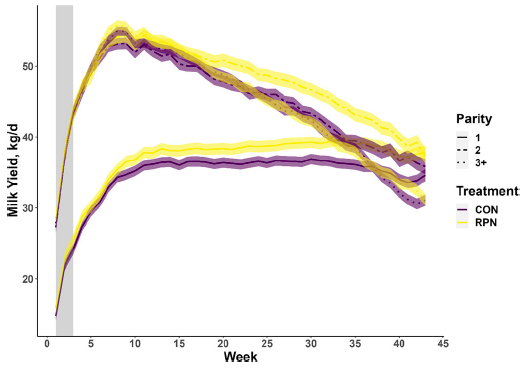
Research Note
Niacin: Optimal Timing for Transition
Supplementing rumen-protect niacin in high-producing cows offers a number of potential benefits. Recent research points to optimal timing for a limited period immediately post-calving, which may increase milk yield over the entire lactation.
Rumen microbes synthesize necessary B-vitamins, including niacin (vitamin B3), from feedstuffs. Unprotected supplementary B-vitamins suffer rumen degradation to varying degrees with the almost complete degradation of niacin. However, with rumen-protected (RPN) supplementation, high-producing cows can improve feed efficiency, fat corrected milk, and milk fat.
In addition, Ohio State’s Dr. Kirby Krogstad notes, RPN fed both pre and postpartum can reduce body fat mobilization (lipolysis), circulating ketones, and maybe the systemic inflammation that occurs after calving. He adds that RPN appears to help “blunt” extremes in the inflammatory response during disease onset.
“Multiple experiments have shown the ‘antilipolytic’ effects of RPN,” Krogstad says. “So we wanted to know whether RPN-reduced body fat mobilization during transition would improve cow health and performance over the course of lactation.”
The researchers zeroed in on RPN supplementation during a 21-day post-calving period, conducting the study on a single Michigan dairy farm that used an automated milking system (AMS). The AMS enabled controlled research into the effects of RPN supplementation in more than 950 cows of multiple parities. They fed RPN only to postpartum cows because previous research suggested that supplementation both before and after calving could reduce milk yields during the first week of lactation.
“We targeted 6 grams per day of supplemental niacin, which was the lowest dose previous research had indicated would change the cows’ peripartum metabolism.”
 Krogstad highlights the performance results: “Rumen-protected niacin increased milk yield for first-parity cows by week 9 of lactation and for and second-parity cows by week 13. Moreover, increased milk yield in those groups was sustained for the rest of lactation.”
Krogstad highlights the performance results: “Rumen-protected niacin increased milk yield for first-parity cows by week 9 of lactation and for and second-parity cows by week 13. Moreover, increased milk yield in those groups was sustained for the rest of lactation.”
Following the 21-day post-calving RPN supplementation, first-parity cows produced an additional 658 kg (± 259.4 kg) of milk and second-parity cows 675 kg (± 308.9 kg).
However, Krogstad points out, in this single on-farm study, RPN supplementation did not affect culling rate, mastitis incidence, or pregnancy rate.
“There’s much more to discover about the metabolic effects of RPN, including optimal timing of supplementation for specific groups of cows on-farm.”
Krogstad is presenting next month at Tri-State and provides dairy research insights through Ohio State extension communications as well as The Cow Professor.
Questions?
Email FeedInsight 4U


